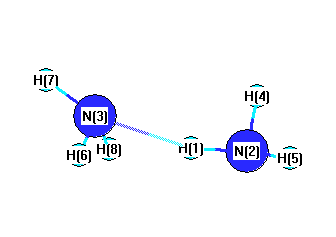Vibrational Frequencies calculated at PBEPBEultrafine/aug-cc-pVTZ
| Mode Number |
Symmetry |
Frequency
(cm-1) |
Scaled Frequency
(cm-1) |
IR Intensities
(km mol-1) |
Raman Act
(Å4/u) |
Dep P |
Dep U |
|---|
| 1 |
Ag |
3487 |
3448 |
0.00 |
|
|
|
| 2 |
Ag |
3369 |
3331 |
0.00 |
|
|
|
| 3 |
Ag |
1624 |
1605 |
0.00 |
|
|
|
| 4 |
Ag |
1048 |
1037 |
0.00 |
|
|
|
| 5 |
Ag |
419 |
414 |
0.00 |
|
|
|
| 6 |
Ag |
128 |
127 |
0.00 |
|
|
|
| 7 |
Au |
3507 |
3468 |
5.62 |
|
|
|
| 8 |
Au |
1631 |
1613 |
19.27 |
|
|
|
| 9 |
Au |
213 |
210 |
70.60 |
|
|
|
| 10 |
Au |
93 |
92 |
19.94 |
|
|
|
| 11 |
Bg |
3507 |
3468 |
0.00 |
|
|
|
| 12 |
Bg |
1621 |
1603 |
0.00 |
|
|
|
| 13 |
Bg |
116 |
115 |
0.00 |
|
|
|
| 14 |
Bu |
3487 |
3447 |
38.02 |
|
|
|
| 15 |
Bu |
3371 |
3333 |
46.63 |
|
|
|
| 16 |
Bu |
1604 |
1586 |
16.41 |
|
|
|
| 17 |
Bu |
1024 |
1013 |
269.13 |
|
|
|
| 18 |
Bu |
88i |
87i |
208.53 |
|
|
|
Unscaled Zero Point Vibrational Energy (zpe) 15079.0 cm
-1
Scaled (by 0.9888) Zero Point Vibrational Energy (zpe) 14910.1 cm
-1
See section
III.C.1 List or set vibrational scaling factors
to change the scale factors used here.
See section
III.C.2
Calculate a vibrational scaling factor for a given set of molecules
to determine the least squares best scaling factor.
Charges, Dipole, Quadrupole and Polarizability
Charges from optimized geometry at PBEPBEultrafine/aug-cc-pVTZ
Charges (e)
| Number |
Element |
Mulliken |
CHELPG |
AIM |
ESP |
| 1 |
H |
0.166 |
|
|
|
| 2 |
N |
-0.390 |
|
|
|
| 3 |
N |
-0.390 |
|
|
|
| 4 |
H |
0.112 |
|
|
|
| 5 |
H |
0.112 |
|
|
|
| 6 |
H |
0.166 |
|
|
|
| 7 |
H |
0.112 |
|
|
|
| 8 |
H |
0.112 |
|
|
|
Electric dipole moments
Electric dipole components in Debye
(What's a Debye? See section
VII.A.3)
| |
x |
y |
z |
Total |
| |
0.000 |
0.000 |
0.000 |
0.000 |
| CHELPG |
|
|
|
|
| AIM |
|
|
|
|
| ESP |
|
|
|
|
Electric Quadrupole moment
Quadrupole components in D Å
Polarizabilities
Components of the polarizability tensor.
Units are
Å
3 (Angstrom cubed)
Change units.
| |
x |
y |
z |
| x |
0.000 |
0.000 |
0.000 |
| y |
0.000 |
0.000 |
0.000 |
| z |
0.000 |
0.000 |
0.000 |
<r2> (average value of r
2) Å
2
| <r2> |
67.913 |
| (<r2>)1/2 |
8.241 |
